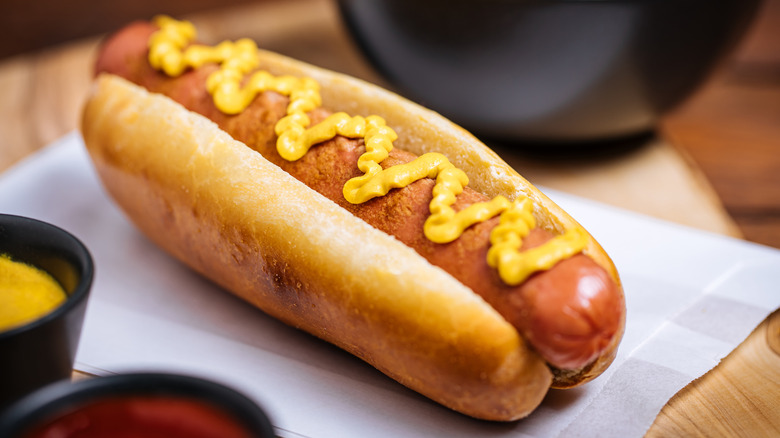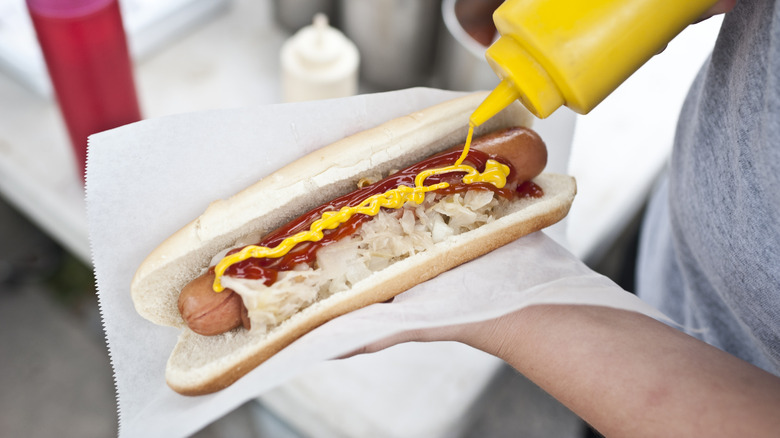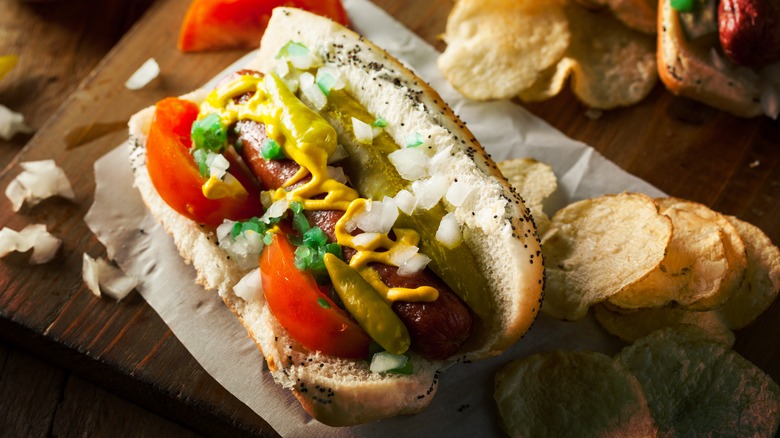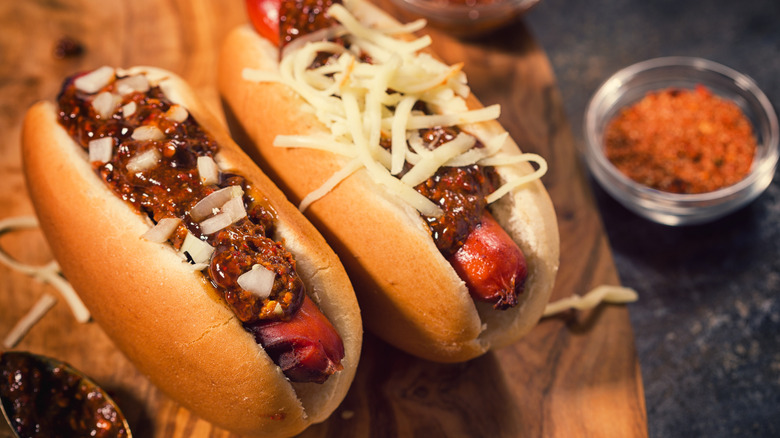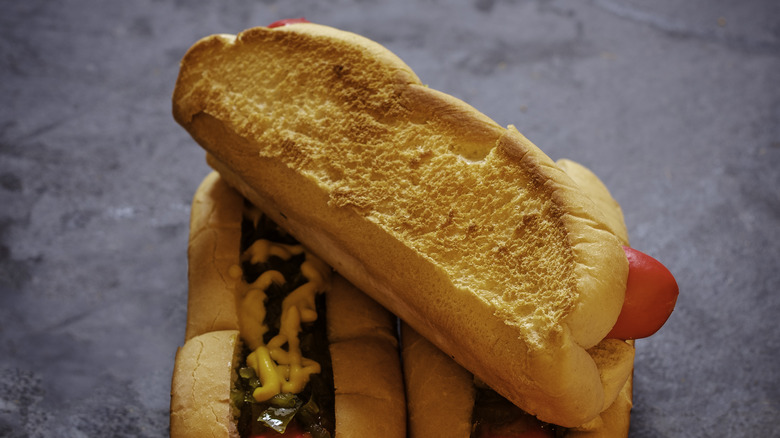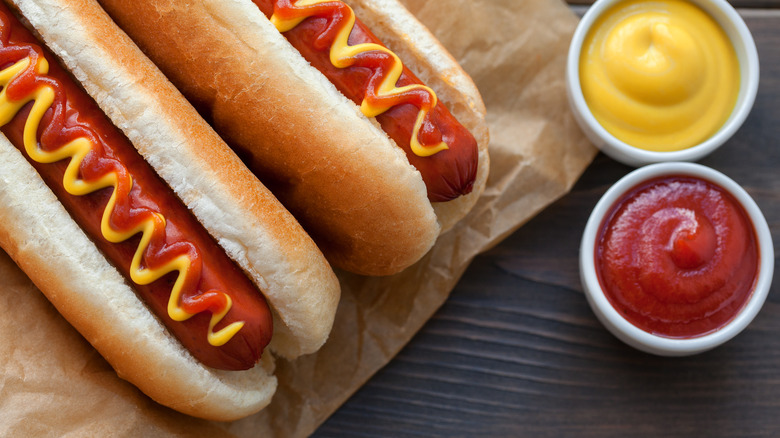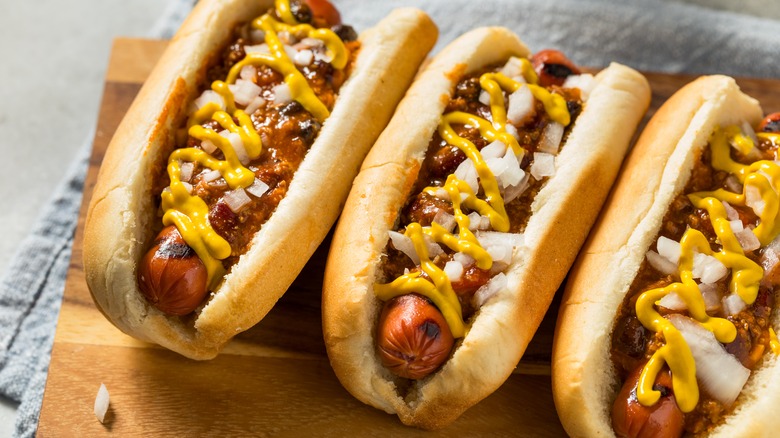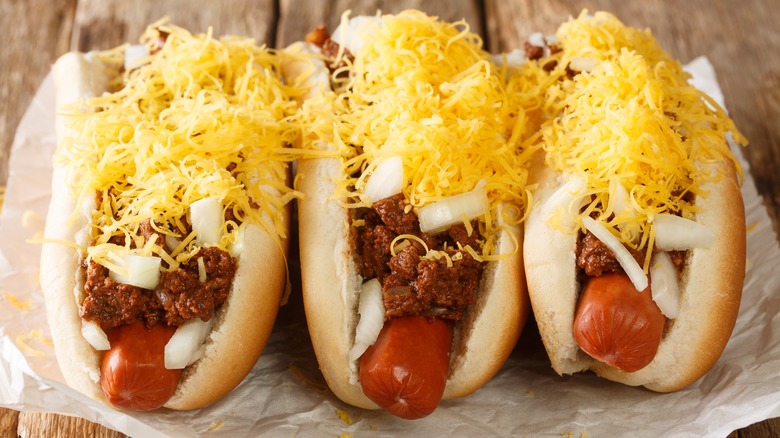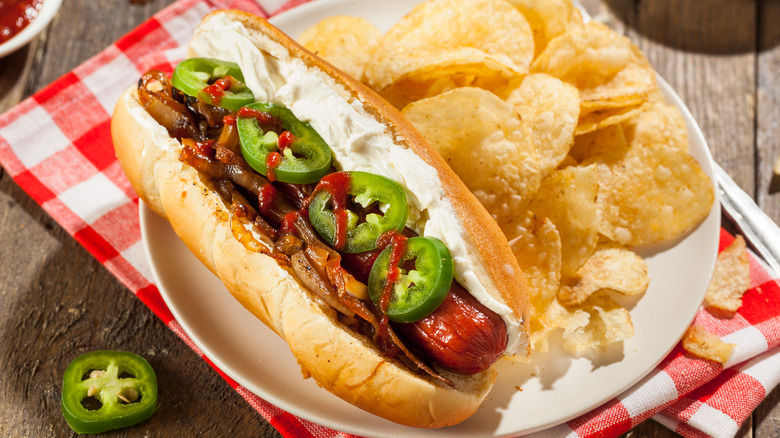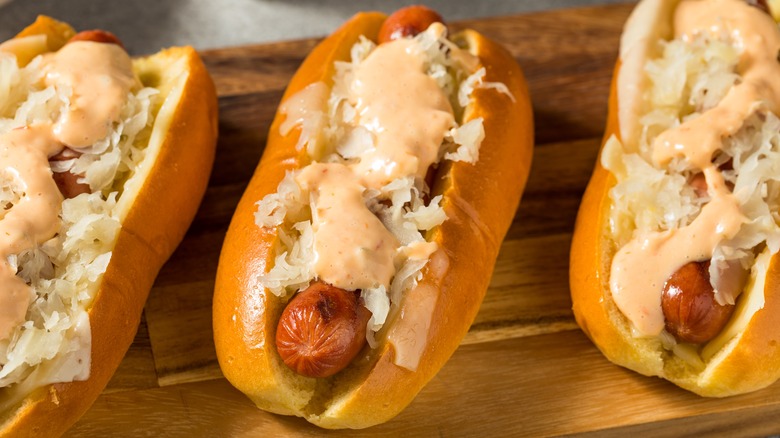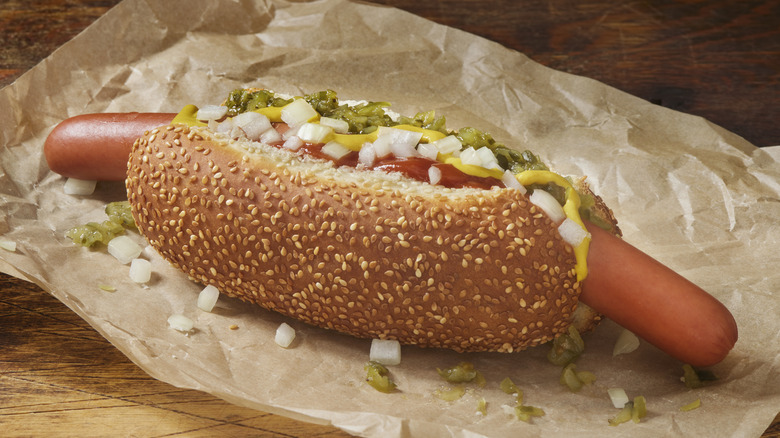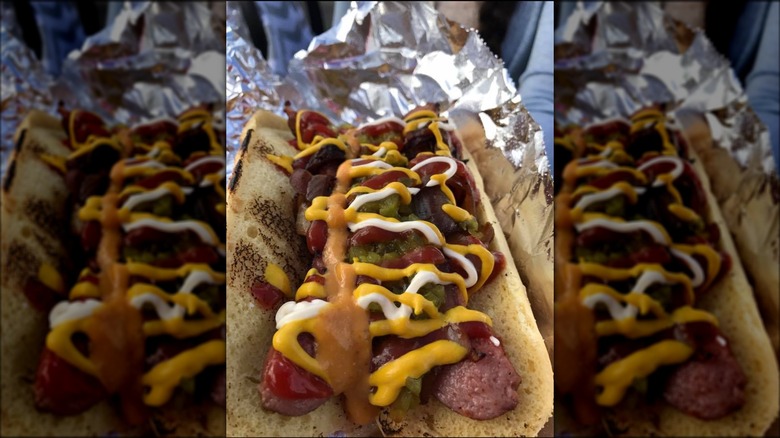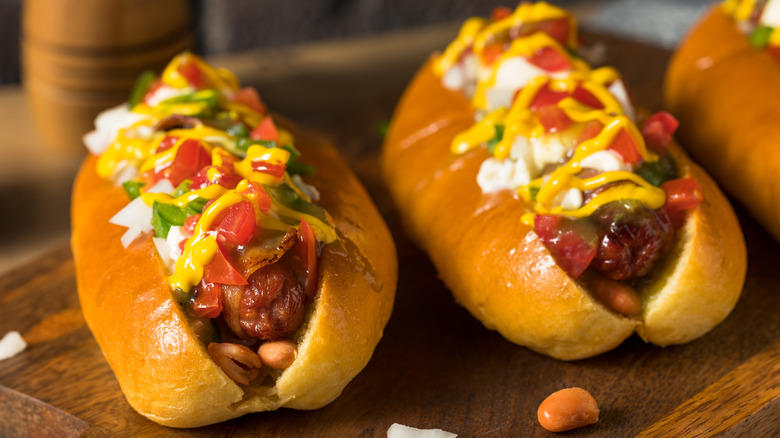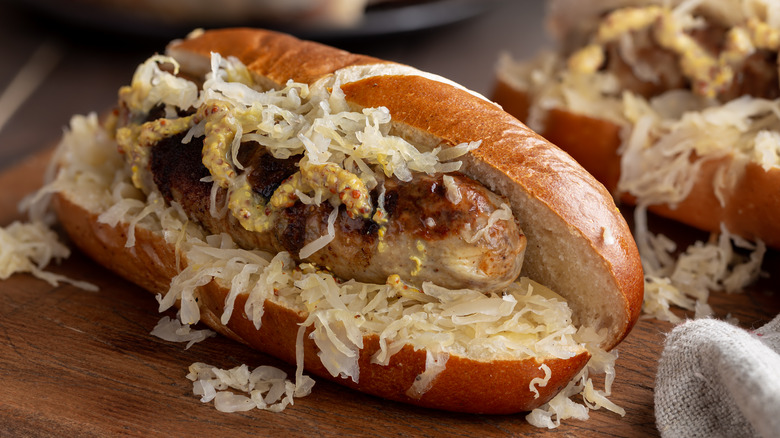The Best Buns For 13 Hot Dog Styles
A classic hot dog on a steamed bun might be the most common way to enjoy a hot dog but there are plenty of styles, each with its own flavor and spin. Some are designed with flavor in mind, adding a sweet note to the salty hot dog and spicy toppings. Others have to be big enough to hold mounds of toppings included in the particular hot dog style. No matter what style you want to try, choosing the right bun is the first and sometimes most important step.
Whether it's a style available in a particular part of the world or a juicy brat, pair your hot dog with the best bun to make the most of the eating experience. Many of the specialty hot dog styles are specific to cities or regions and feature ingredients that make their style of cuisine unique. Think of Arizona and Mexico and you're likely to picture salsa, crema, and delicious beans, which is exactly what you'll find on a Sonoran dog. A Chicago-style hot dog, on the other hand, includes onions, tomato, mustard, peppers, and the all-important sweet pickle relish on top. Others evolved in unexpected ways, including the iconic onions and mustard toppings on New York City hot dogs. No matter its origins, each hot dog style has become synonymous with a specific flavor and type of bun.
New York hot dog
If you're getting a hot dog in the Big Apple, you need an equally big bun. A steamed hot dog bun works well; just make sure it's sturdy and long enough to hold the dog, onions, and mustard that characterize a NYC hot dog. The bun should be soft but not overpower the actual hot dog, which is the star of the show when it comes to serving up this snack New York-style. Nathan's Famous and Sabrett's are two brands that started in New York and are now sold in supermarkets so you can get the juicy hot dogs without dealing with city traffic. Aside from holding the dog and toppings, the bun doesn't need to do much else.
You can find authentic NYC hot dogs at a corner stand, most notably from the Sabrett carts sporting blue and yellow umbrellas. At the carts, hot dogs are served with onions and mustard, although some restaurants and upscale vendors looking to put their twist on the classic opt for fancier deli mustard or a pickled onion relish. Nathan's Famous, a Brooklyn legend since 1916, makes their own super juicy franks and serves them on thin buns. Sabrett's is known for the natural casing they use to make their franks, which gives the hot dogs a distinct texture with each bite that they call "the snap."
Chicago-style hot dog
Traditional Chicago-style dogs are served on poppyseed buns. Chicago-style hot dogs have some of the most distinct requirements for a great bun because they don't just hold the dog but also add flavor and texture. The stronger flavor of the poppyseed bun can hold up to the long list of toppings on these hot dogs, which include raw onions, mustard, relish, peppers, tomatoes, and pickles.
The toppings are what make the hot dog, which typically features a 100% beef link, into a meal that could keep a customer full for an entire day's work. Chicago-style hot dogs became popular during the Great Depression when food needed to be cheap and hearty. They were originally sold for just five cents in the 1930s under the name "depression sandwich." The pickle is often a full spear, which is tucked into the side of the bun next to the hot dog. There is also a specific order for condiment application and the best stands always adhere to it. Mustard and relish go first because they coat the inside of the bun but ketchup is banned on a Chicago-syle dog. Onions, tomatoes, pickles, and peppers follow. The hot dog is finished with a dash of celery salt.
Kansas City hot dog
Look for a giant or jumbo bun to hold Kansas City-style hot dogs, which are often topped with brisket, pulled pork, or barbecue burnt ends, a Kansas City specialty. In a city known for its barbecue, Kansas City natives and visitors often slather this sweet and spicy condiment over everything from hot dogs to burgers. Kansas City barbecue has a sweet and smoky flavor, and is tomato-based, which adds a lot of flavor to the hot dogs when used as a condiment or topping so the bun needs to be soft enough to soak up an extra sauce. Burnt ends have a bit of crunch and char, making them a great pairing for a juicy dog. When you combine barbecue, burnt ends on a pillowy soft bun, you get extra flavor and texture with the hot dog serving as a base. The bun should be pretty hefty since it has to hold up to a hot dog and toppings that are often spilling out the top and over the sides.
Some Kansas City locals top hot dogs with sauerkraut, a nod to the region's German origins. These dogs are typically served on buns loaded with sesame seeds and sometimes topped with Swiss cheese in addition to kraut. But neither style has the dedicated following from KC locals that other cities like New York or Chicago can claim with their hot dogs and you can find both in KC.
New England hot dogs
New England-style hot dogs aren't so much about the dog as they are the bun itself. New England buns are cut all the way across at the top, creating a hefty square base for the dog and condiments to rest in. These buns are also called split top rolls due to how their tops are configured. Because they have a wide base, you can load up your hot dog with plenty of toppings and not worry about it tipping over. Toast your bun with butter on the outside for extra flavor, a preferred method of preparation for the popular lobster rolls that the region is known for.
These buns were first developed to hold fried clams, which they still do, in the 1960s. The main thing that restaurants wanted was a bun that wouldn't tip over as you filled it. The split top bun was born and only got better with time. They're sold labeled as hot dog rolls but you can use these split top buns for just about any kind of sandwich, especially those with plenty of goodness on the inside that you want to contain. For true New England flavor, grill a red snapper hot dog, a variety unique to Maine, and serve it in a grilled split top bun.
Coney Island hot dog
Hot dogs began as a street food on Coney Island that allowed patrons for a quick and easy bite while at the beach; thus, the bun was key to its portability. As early as the mid-1860s, beachgoers were able to grab a dog in a soft bun and stroll in the sand as they ate. German immigrant Charles Feltman was credited with serving the original Coney Island hot dog. In its heyday, the outdoor structure known as Feltman's Ocean Pavilion sold as many as 40,000 hot dogs each day. Eventually, one of his employees ventured out on his own and Nathan's Famous Hot Dogs were born. These franks even rank high on lists of the best hot dogs that you can buy at the grocery store, although they don't come with a refreshing waterfront breeze.
Today, Coney Island-style hot dogs are served at the same establishments (plus many more) where they started on traditional buns with mustard. Nathan's Famous even sponsors a hot dog eating contest at Coney Island. The toppings tend to be pretty simple and you can dress up your dog as you see fit with ketchup, mustard, or relish. But the buns are key in this beach-loving neighborhood because they still serve their original purpose of letting happy customers enjoy a juicy dog without the need for anything other than their appetite.
Michigan Coney hot dog
As you head west from New York, a Coney dog takes on a new meaning. In Michigan, a Coney dog is a beef hot dog topped with chili, white onions, and mustard and traditionally served on a steamed roll. The hot dog should be made of beef and very juicy, which works well with the soft bun. It's also important that the chili is free of beans for a true, authentic Coney dog. If you can, get Michigan-made beef franks as well.
The origin of the name is still a mystery but the best guesses say that immigrants from Greece passed through New York's Coney Island and used the name as inspiration when setting up their own hot dog establishments. The two most popular in Detroit, American Coney and Lafayette Coney, were started by two brothers around 1917 and 1924, respectively, although some records identified the origins of the two establishments as late as 1923 and 1936. The intrigue and rivalry between the two, which are located next door to each other, is only outdone by their dogs. They're still in the same spots serving up the same delicious Coney dogs today.
Cincinnati Coney hot dog
Another hot dog that takes its inspiration from Coney Island is the Cincinnati Coney. It is served with Cincinnati-style chili, onion, and cheese on top of a subtly sweet brioche bun. A potato roll also works because it has a subtle sweet flavor and super soft, pillowy texture. These hot dogs are also loaded with toppings so make sure to pick a bun that is large enough not just for the dog but a little bit extra as well. The bun's hint of sweetness is key when it comes to flavor.
Cincinnati dogs are topped with bean-free Cincinnati chili, which has a sweet flavor thanks to spices such as cinnamon and allspice. It also has a finer texture than some other chilis, which makes the soft bun even more important since it will soak up all the extra chili juices and flavor. The sweet brioche or potato buns also pair well with the slightly sweet chili. The dogs are served with mustard and onions, two traditional hot dog condiments. But a generous helping of shredded cheddar cheese puts them over the top.
Seattle-style hot dogs
Seattle-style hot dogs are traditionally served on a specialty hot dog bun made from bagel dough. The style first appeared around 1989 and many claim it was invented by bagel cart vendor Hadley Long. The buns were similar to a biyali because they used bagel dough but weren't boiled prior to baking. Instead, Long used buns that were put right in the oven because he needed something quick to satisfy all of the hot dog-loving patrons who came by his cart. When the buns were done, he loaded them up with the dog, slathered them with cream cheese, and added some onions.
If you can't find a bagel-dough bun, look for an alternative that is super soft, which works well with the hot dog topped with cream cheese, grilled onions, and even jalapeño. These hot dogs are not heavy on toppings, although most dog places will have the basics like ketchup, relish, onions, and peppers available. The bun and the cream cheese are the true stars of the Seattle hot dog show; it's what set it apart from other styles.
Reuben hot dog
You can find these Reuben-style hot dogs in Kansas City but they pop up on menus all around the country as well. Serve them in French bread rolls split down the middle and top with pastrami, sauerkraut, Swiss cheese, and Thousand Island dressing, just like a Reuben. Because they are full of toppings, make sure the bun is sturdy enough to hold everything in one place. A split top bun works well because it has a square base, perfect for holding the hot dog while you add plenty of kraut.
The Reuben dates back to the 1920s and two of the most prominent theories state that it started in either Nebraska or New York. But you can find pastrami-loaded sandwiches and similar flavors in other areas as well. The iconic Reuben flavors include pastrami, sauerkraut, and Swiss cheese but you can add any of these by themselves for a delicious dog as well.
Dodger dogs
These giant hot dogs are a staple at Dodger Stadium in Los Angeles where they get their name. The buns have a traditional taste and texture but are notably a few inches shorter than the dogs themselves. Dodger dogs come with traditional toppings, including ketchup, mustard, and relish which are available at stands near the hot dog vendors at the ballpark. But it's the bun-to-hot dog ratio that really makes the dog stand out.
Dodger dogs are a whopping 10 inches long. Compared to most hot dogs, which are between 4 and 6 inches, these dogs are massive. What makes a Dodger dog unique is that each end hangs over the buns so the first few bites are likely to be all dog and no bun. They're the perfect addition to a bag of peanuts, which you can also get at Dodger Stadium, and a day spent watching the ballgame.
Reindeer dogs
Contrary to what their name suggests, these hot dogs popular in Alaska are usually made with caribou, pork, and beef, often blended. This type of meat is easier to find in Alaska and you can even get them premade as Alaskan hot dogs. Sometimes the dogs are cooked with Coca-Cola caramelized onions, which gives it a sweet flavor. A steamed bun works well with reindeer dogs and is easy to find at most supermarkets. Alaskan reindeer dogs are all about the hot dog, so the bun should be solid but nothing fancy so as not to draw attention away from the juicy meat.
They come with toppings like those sweet onions, relish, ketchup, mustard, and even cream cheese on a steamed bun. But the dog is the most important part of a reindeer dog and other than onions, the toppings vary widely based on the diner's preference. Because of their popularity, reindeer dogs have spread to other West Coast states as well where each region puts its own spin on the toppings. Cream cheese is more common in Washington, where reindeer dogs sometimes pop up since the creamy addition is a staple in a Seattle-style hot dog. A steamed bun still works but you can also find them on Seattle-style bagel dough buns.
Sonoran hot dog
Named for the Sonoran desert region, these hot dogs are popular on menus in Arizona and the surrounding states, although they trace their origins to Mexico. Look for a slightly sweet bun that works well with the bacon-wrapped hot dog, crema, salsa, and pinto beans. A Sonoran dog is known for its rich flavor, from the sweet bread to the savory hot dog and salty bacon, so don't overlook the importance of the bun. Add in some creamy beans and crema and finally the salsa with just the right amount of heat for a meal in one delicious handheld dog. These hot dogs have generous portions of toppings so the bun also needs to be large enough to hold everything together.
If you can't find the right bun, you can make your own Sonoran-style bun. The secret is to start with a flour, milk, and yeast slurry, also known as a tangzhong starter, which will work to create a super soft texture as the bread bakes. It also helps create the slightly sweet taste that works so well with a Sonoran dog.
Brats and sausages
Hot dog styles might be characterized by their toppings, dogs, or buns but bratwurst and sausages also have specific requirements when it comes to pairing the best bun with the meat. But there are flavor differences between a bratwurst and a hot dog. Bratwursts have a stronger flavor with added unique spices (like nutmeg or caraway seeds) using only one type of meat at a time, whereas hot dogs have a milder flavor due to the mixture of different meats and only common spices. This typically means you'll need a hefty bun so look for a giant or jumbo option or one made specifically for brats.
Don't put a juicy brat or sausage on a plain old hot dog bun. Instead, upgrade to a hoagie roll or pretzel bun that can hold up with the larger frank and bigger flavors. You can use many of the same toppings, including traditional options like ketchup, mustard, and relish. It's also a great idea to substitute a brat or sausage for a hot dog in special regional styles as well. Just make sure to upgrade your bun so that it can handle the extra work of containing the delicious goodness of a brat or sausage.
